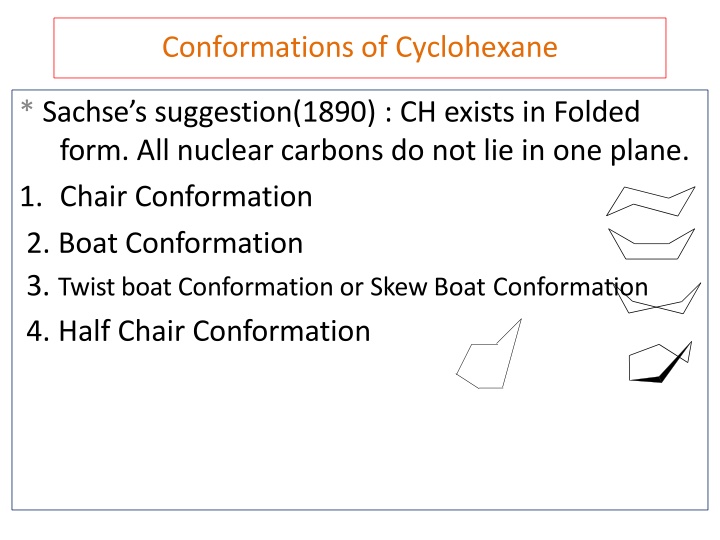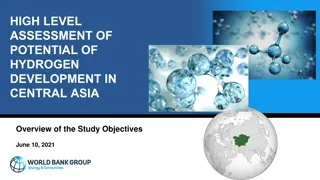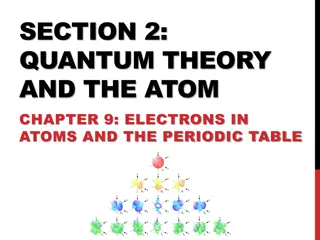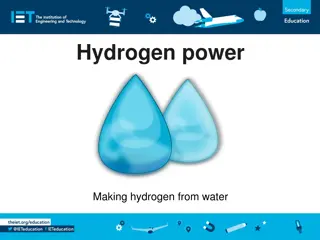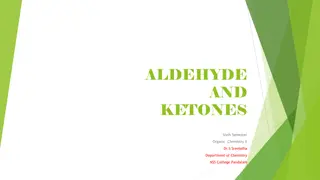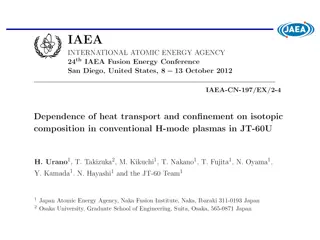Conformations of Cyclohexane and Hydrogen Atom Types
Different conformations of cyclohexane including chair, boat, twist boat, and half chair conformations. Learn about the arrangement of axial and equatorial bonds, steric strain, and types of hydrogen atoms in boat conformation. Discover variations like the twist boat and half chair conformations.
Download Presentation

Please find below an Image/Link to download the presentation.
The content on the website is provided AS IS for your information and personal use only. It may not be sold, licensed, or shared on other websites without obtaining consent from the author.If you encounter any issues during the download, it is possible that the publisher has removed the file from their server.
You are allowed to download the files provided on this website for personal or commercial use, subject to the condition that they are used lawfully. All files are the property of their respective owners.
The content on the website is provided AS IS for your information and personal use only. It may not be sold, licensed, or shared on other websites without obtaining consent from the author.
E N D
Presentation Transcript
Conformations of Cyclohexane * Sachse s suggestion(1890) : CH exists in Folded form. All nuclear carbons do not lie in one plane. 1. Chair Conformation 2. Boat Conformation 3. Twist boat Conformation or Skew Boat Conformation 4. Half Chair Conformation
Chair Conformation Shape : Like a Chair No. of Carbon atoms All Carbon atoms Bond angle between any two bonds : 109028 No. of Hydrogen atoms : 12 Two sets of Hydrogen atoms : 06 + 06 a) Axial hydrogen atoms b) Equatorial hydrogen atoms : 06 sp3hybridised :
Axial and Equatorial Bonds in Cyclohexane There are two kinds of positions for substituents on the cyclohexane ring Axial positions 6 axial positions perpendicular to ring and parallel to ring axis. Bonds in these positions are axial bonds and atoms/grps. are axial Equatorial positions 6 equatorial positions are in rough plane of the ring around the equator, i. e. Projecting outwards the ring. Bonds in these positions are equatorial bonds and atoms /grps are equatorial
Boat Conformation of Cycohexane Shape : Like a boat No. of Carbon atoms All Carbon atoms Bond angle between any two bonds No. of Hydrogen atoms Four types of Hydrogen atoms a. Flag pole Hydrogen atoms b. Bow-sprit Hydrogen atoms c. Quasi axial Hydrogen atoms d. Quasi equatorial Hydrogen atoms : 06 : SP3hybridised : 109028 : 12 : 2 + 2+ 4+4 :2 :2 :4 : 4
Steric Strain Steric strain is the increase in potential energy of a molecule due to repulsion between groups on non-neighbouring carbons
Types of Hydrogen atoms in Boat Conformation RingAxis Hfp Hfp Hbs Hbs Hqe Hqe Hqe Hqe Hqa Hqa Hqa Hqa fp : FlagPole, bs : Bow sprit , qa : quasiaxial, qe : quasieqautorial
Twist Boat and Half Chair Conformations Twist Boat : Twisting of the boat results in release in steric strain due to fp-fp interactions.H H H H H H H H Half Chair Conformation : If C1 or C4 of chair conformation is brought in the average plane of the ring, the resulting conformation is known as Half chair conformation.The conformation has both angle strain and torsional strain H H H H H H H H
Stability of Conformations of Cyclohexane Decreasing Order of Stability Chair > Twist Boat > Boat > HalfChair
Explanation Stability Factors contribute to instability of conformations 1. Bond distortion strain 2. Charge repulsion strain 3. Bond oppositionstrain 4. Stericstrain In cyclohexane due to ring puckering and uncharged nature bond opposition and charge repulsion strain are irrelevant. Bond opposition and steric strain contribute to internal strain in CH. Different conformations of CH differ in internal strain and hence in PE content.
1. chair conformation: Bond opposition and steric strain are minimum. a) C-H bonds are perfectly staggered Bond opposition strain is minimum. b) H atoms on adjacent carbon atoms have enough space for their accommodation. ( Sum of van der Waal s is 2.5Ao , where as a and e H atoms on adjacent C atoms are separated by 2.3o.) Steric strain is minimum. H H H H H 1 H H 6 H H 2 1 H H H H 5 3 2 6 4 H H 5 H 3 H H H 4 H H H H H Therefore PE content of chair conformation is minimum. Hence it is most stable.
Boat Conformation: suffers from two strains 1. Bond opposition strain: C-H bonds on the sides are eclipsed. 2. Fp Fp interaction: Distance betweentwo Fp Hs is 1.84Ao Distance required is 2.5Ao These two strains make boat conformation highly strained. It has 29.71kJ/mol more energy than chair conformation. 1.84A0 H H H H H H 1 H H 4 H 1 H H H H H 4 2 3 6 5 2 H 3 H H 6 H 5 H H H H H H Therefore boat conformation is less stable than chair conformation. Thermodynamic calculations : 0.1 to 0.2 % boat form i.e. 1 or 2 molecules per thousand.
Twist or Skew boat Conformation: Less torsional strain as compared to boat conformation. Flag pole Hs are away from each other. C2, C3, C5 and C6 become non-planer. H Fp H Fp H H 1 4 2 6 5 3t but 23.02kJ Energy content : 6.696kJ less than boa more than chair. Therefore more stable boat but less stable than chair.
Half chair conformation: Suffers from angle strain H 4 H H H 2 3 H H H H 1 6 H 5 H H H It has 46.04kJ more energy than chair conformation. Maximum energy content than any other conformation. There it is least stable.
Isolation of any conformation of CH is not possible because : At RT the average energy content of CH is more than sufficient to overcome this small barrier. There exists a dynamic equilibrium between different conformations of CH. Chair Twist Boat Boat Half Chair
Energy Profile diagram Boat29.7kJ/mol TB :23.02kJ/mol HC:46.04kJ/mol
Torsional Strain Torsional strain is the resistance to bond twisting in a chemical compound. When the atoms separated by three bonds are placed in eclipsed conformation instead of stable staggered conformation, then it causes torsional strain between the bonds. It is related to the bond angle in relation to rotation of bonds. In case of staggered conformation (anti), torsional strain is minimized as the two methyl groups (large groups) are farthest apart. In case of staggered conformation (gauche) torsional strain is increased as the two methyl groups (large groups) are very close together. In case of eclipsed conformation torsional strain is maximized with very high energy as the two methyl groups (large groups) are in close proximity.
Locking of Conformation In substituted cyclohexane small substituent may acquire either axial or equatorial position. e.g. But with increase in size of the substituent 1,3-diaxial interactions become very severe increasing internal PE. Thereby stability is decreased. Very large substituents like t-butyl prefer to lie in equatorial position only to interactions The existence in only one conformation is termed as locking of conformation. avoid 1,3 diaxial
